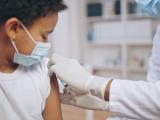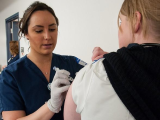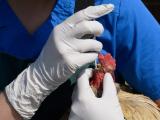Aug 10, 2011
Egyptian girl contracts H5N1 flu
A 6-year-old girl in Egypt has contracted H5N1 avian flu, marking the country's 32nd confirmed H5N1 case this year, the World Health Organization (WHO) reported yesterday. Citing the Egyptian Ministry of Health, the WHO said the girl, from Beheira governorate, developed symptoms Jul 12 and was hospitalized. After completing a course of oseltamivir (Tamiflu), she was discharged from the hospital on Jul 30. Egyptian Central Public Health Laboratories confirmed her H5N1 diagnosis, and investigations indicated that she had been exposed to poultry "suspected to have avian influenza." Of the 32 Egyptian cases this year, 12 have resulted in death. Since 2006 the country has confirmed 151 H5N1 cases, including 52 deaths. The global total now stands at 564 cases and 330 deaths.
Aug 9 WHO update
Cell-based trivalent flu vaccine shown effective in large trial
Protein Sciences Corporation's insect-cell–based influenza vaccine FluBlok was found safe and immunogenic in a phase 3 clinical trial involving more than 4,000 healthy adults ages 18 to 49. Researchers from Protein Sciences, based in Meriden, Conn., and other US institutions recruited volunteers from 24 centers across the country. They were divided into a 2,304-subject control group and a 2,344-subject vaccine group, which received one intramuscular shot containing 45 micrograms of hemagglutinin (HA) for each of the three strains. Rates of side effects were low in both groups. HA-inhibition (HAI) antibody responses were seen in 78%, 81%, and 52% of FluBlok recipients to the H1, H3, and B components of the vaccine, respectively. FluBlok was 44.8% effective (95% confidence interval, 24.4% to 60.0%) in preventing influenza during the 2007-08 season despite a significant mismatch between the vaccine strains and circulating viruses. The authors conclude, "FluBlok induced serum HAI antibody responses to all three vaccine components in the majority of recipients, and the lower limit of the 95% confidence interval for response rate exceeded the [Food and Drug Administration] criteria for licensure for all three components (lower limit of the 95% confidence interval for response rate >40% and lower limit of the 95% confidence interval for HAI titer of 1:40 or greater >70%)."
Aug 9 Vaccine abstract
Study: H1N1 patients with underlying conditions shed virus longer
One fourth of pandemic 2009 H1N1 flu patients taking oseltamivir shed virus 5 days after illness onset, with those who had underlying conditions shedding the virus longer, according to a Thai study in the Journal of Infection yesterday. The researchers studied 357 confirmed H1N1 cases (122 inpatients, 235 outpatients) from June through September 2009 in patients who received a 5-day course of oseltamivir, 36% of whom had underlying illnesses. Using nasal swab specimens, they found that the duration of virus shedding ranged from 1 to 14 days after illness onset, with a median of 3 days. Polymerase chain reaction tests were positive on day 5 of treatment for 24 of 91 patients (26%), with those who had underlying illness having a higher rate—45% (15/33) versus 16% (9/58). The researchers sum up: "An extended course of antiviral treatment should be considered in patients with underlying diseases and severe clinical symptoms."
Aug 9 J Infect abstract


















